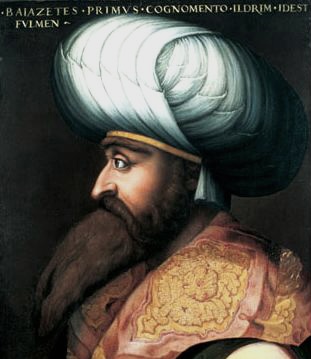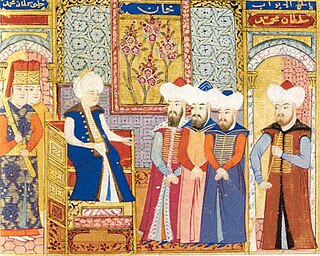
Bayezid I, also known as Bayezid the Thunderbolt, was the sultan of the Ottoman Empire from 1389 to 1402. He adopted the title of Sultan-i Rûm, Rûm being the Arabic name for the Eastern Roman Empire. In 1394, Bayezid unsuccessfully besieged Constantinople. In 1402, he once more besieged Constantinople, appearing to find success, but he ultimately withdrew due to the invasion of the Mongol conqueror Timur. He defeated the Crusaders at the Battle of Nicopolis in what is now Bulgaria in 1396. He was later defeated and captured by Timur at the Battle of Ankara in 1402 and died in captivity in March 1403, which triggered the Ottoman Interregnum.

Mehmed I, also known as Mehmed Çelebi or Kirişçi, was the sultan of the Ottoman Empire from 1413 to 1421. The fourth son of Sultan Bayezid I and Devlet Hatun, he fought with his brothers over control of the Ottoman realm in the Ottoman Interregnum (1402–1413). Starting from the province of Rûm he managed to bring first Anatolia and then the European territories (Rumelia) under his control, reuniting the Ottoman state by 1413, and ruling it until his death in 1421. Called "The Restorer," he reestablished central authority in Anatolia, and he expanded the Ottoman presence in Europe by the conquest of Wallachia in 1415. Venice destroyed his fleet off Gallipoli in 1416 as the Ottomans lost a naval war.

Murad II was twice the sultan of the Ottoman Empire from 1421 to 1444 and from 1446 to 1451.

The Karamanids, also known as the Emirate of Karaman and Beylik of Karaman, was one of the Anatolian beyliks, centered in South-Central Anatolia around the present-day Karaman Province. From the mid 14th century until its fall in 1487, the Karamanid dynasty was one of the most powerful beyliks in Anatolia.

The Candar dynasty, also known as the Isfendiyar dynasty, was an Oghuz Turkic princely Anatolian dynasty that reigned in the territories corresponding to the provinces of Eflani, Kastamonu, Sinop, Zonguldak, Bartın, Karabük, Samsun, Bolu, Ankara and Çankırı in present-day Turkey from the year 1291 to 1461. The region was known in Western literature as Paphlagonia, a name applied to the same geographical area during the Roman period.

Anatolian beyliks were small principalities in Anatolia governed by beys, the first of which were founded at the end of the 11th century. A second and more extensive period of establishment took place as a result of the decline of the Seljuq Sultanate of Rûm in the latter half of the 13th century.

The Burji Mamluks or Circassian Mamluks, sometimes referred to as the Burji dynasty, were the rulers of the Mamluk Sultanate of Egypt from 1382 until 1517. As with the preceding Bahri Mamluks, the members of the Burji Mamluk ruling class were purchased as slaves (mamluks) and manumitted, with the most powerful among them taking the role of sultan in Cairo. During this period, the ruling Mamluks were generally of Circassian origin, drawn from the Christian population of the northern Caucasus. The name Burji, meaning 'of the tower', refers to the traditional residence of these Mamluks in the barracks of the Citadel of Cairo.

The Classical Age of the Ottoman Empire concerns the history of the Ottoman Empire from the conquest of Constantinople in 1453 until the second half of the sixteenth century, roughly the end of the reign of Suleiman the Magnificent. During this period a system of patrimonial rule based on the absolute authority of the sultan reached its apex, and the empire developed the institutional foundations which it would maintain, in modified form, for several centuries. The territory of the Ottoman Empire greatly expanded, and led to what some historians have called the Pax Ottomana. The process of centralization undergone by the empire prior to 1453 was brought to completion in the reign of Mehmed II.

The Ottoman-Mamluk war took place from 1485 to 1491, when the Ottoman Empire invaded the Mamluk Sultanate territories of Anatolia and Syria. This war was an essential event in the Ottoman struggle for the domination of the Middle-East. After multiple encounters, the war ended in a stalemate and a peace treaty was signed in 1491, restoring the status quo ante bellum. It lasted until the Ottomans and the Mamluks again went to war in 1516–17; in that war the Ottomans defeated and conquered the Mamluks.
Ibrahim II was a bey of Karaman. In 1425 he married Ilaldi Sultan Hatun, a daughter of Ottoman Sultan Mehmed I. They had six sons among them Ishak Bey, Pir Ahmet Bey and Kaya Bey, who married his cousin Hafsa Hatun, daughter of Murad II, and had a son, Kasım Bey.

Nasiraeddin Mehmed II of Karaman, also Mehmed Beg, Mehmed Beg II or Nasir al-Din Mehmed Beg was the Bey ruler of Karaman. His mother was Nefise Hatun, a daughter of Ottoman Sultan Murad I.
Juneyd or Junayd Bey was the last ruler (bey) of the Aydınid principality in what is now central western Turkey. His exact relationship with the Aydınid dynasty is unclear. His father was a long-time and popular governor of Smyrna under the Ottoman sultan Bayezid I. This allowed Junayd to consistently rely on the loyalty of the area's populace.
Yakub II, also known as Yakub Chelebi, was Bey of Germiyan in western Anatolia from 1387 to 1390, 1402 to 1411, and 1414 until his death. Yakub was the patron of several literary and architectural works produced during his reign.
Karim al-Dīn Ḳarāmān Beg was a Turkoman chieftain who ruled the Karamanids in the 13th century. Ḳarāmān Beg's emergence coincides with the defeat of the Sultanate of Rum by the Mongolian Empire in 1256 and the tension between Kaykaus I and his rival brother Kilij Arslan IV, which allowed local lords living along the boundaries of the state to exercise some autonomy.
Shams al-Dīn Meḥmed I Beg was Beg of Ḳarāmān from 1263 until his death. Ḳarāmān was a Turkish principality in Anatolia in the 13th century. His father was Karaman Bey.
Alaattin Ali of Karaman (d.1397), also Alaeddin Ali, was a bey of Karaman Beylik, a Turkish principality in Anatolia in the 14th century. Like most other Karaman beys, Ali Bey was a rival of the rising Ottoman Empire, and the two principalities engaged in chronic wars against one another.
Ishak of Karaman was a bey of the Karamanids, a Turkish principality in Anatolia in the 15th century.

Ottoman wars in Asia refers to the wars involving the Ottoman Empire in Asia. Ottoman Empire was founded at the beginning of the 14th century. Its original settlement was in the northwest Anatolia where it was a small beylik (principality). Its main rival was Byzantine Empire. In 1350s Ottomans were able to cross the Dardanelles strait and eventually they conquered most of the Balkans. Although they mainly concentrated their expansions in Europe, they also expanded their territories in Asia, mainly in Fertile Crescent and Arabian Peninsula.
Nefise Melek Sultan Hatun was an Ottoman princess, the daughter of Sultan Murad I of the Ottoman Empire. She was the wife of Alaeddin Ali Bey of Karaman, the ruler of Karamanids, the mother of the next Karamanid ruler, Mehmed II of Karaman and the first political active Ottoman princess known.
Nasir al-Din Mehmed Beg was the ruler of Dulkadir from 1399 until his death. He came to power with the intervention of the Ottoman Sultan Bayezid I amidst the internal struggles within the Dulkadirids and forced his cousin Sadaqa to flee from Elbistan, the capital. During the Ottoman Interregnum (1402–13), Mehmed supported Bayezid's son Mehmed Chelebi, who became the new sultan succeeding his father, Bayezid I. While Nasir al-Din Mehmed was involved in sporadic clashes with the Mamluks, he enjoyed peace with them towards the end of his reign, marrying his daughter to the Mamluk Sultan and commissioning the construction of madrasas and other buildings in regions outside his control, such as in Jerusalem.










